The worldwide pandemic transferred the shopping process to the online space, so more than 40% of customers prefer online shopping rather than physically going to stores. But it should be mentioned that marketplace platforms are convenient not only for buyers but for sellers too, providing almost everybody with an opportunity to enter the internet market. You need only to facilitate a purchasing process, offering goods online.
Such simplicity and convenience cause the growth of the Sharing economy sector (including peer-to-peer markets). It’s predicted to reach $355 billion by 2025 — a compelling argument to implement your idea. So, let’s find out how to build a marketplace site and succeed.
Things to Do Before You Start
Every fantastic idea found needs to be adapted to the current business reality. That’s why you should always analyze the market situation to define the sector you’ll be targeted before starting a project. That’s why let’s research the marketplace stats.
The peer-to-peer marketplace platforms (such as eBay, Amazon, and Airbnb) are expected to generate over $7 trillion in revenue, accounting for 90% of all web sales worldwide by 2024. From 2021 to 2028, the worldwide marketplace market is going to increase at a compound annual growth rate of 9.7%.
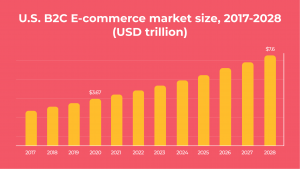
The primary reasons that have led to such global rise are the following:
- A digital purchasing comfort due to widespread mobile gadgets
- Changes in customers’ shopping habits because of pandemic
- A growing amount of online shoppers.
- Broad usage of AI
- The chaotic condition of the modern offline retail industry
More and more merchants regard marketplaces as the best way for upgraded online sales, lowering costs, automating operations, and so on.
The Major Reasons to Create a Marketplace Website
After studying the market environment and defining its potential, you can choose the appropriate business model and develop your own product. Use the following key preferences to obtain profit:
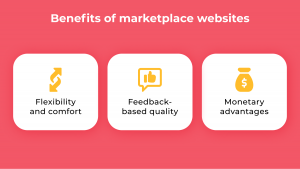
-
- Flexibility and comfort. You’ve got freedom of domain choice or product’s functionality one. At the same time, the users (both the buyers and sellers) of your upcoming platform would attract each other, and your marketing campaigns might be more successful.
- Feedback-based quality. You can provide your customers with estimating features, such as a product overview or a rating mechanism, to obtain deep feedback and have an opportunity to improve the solution.
- Monetary advantages. Gain profit with little effort. You need to build a software product, and if it is top-notch, it would start attracting people by itself. While you work, your bank account grows.
How to Build a Marketplace Website
To develop a successful commercial platform, you need to pass through the following stages:
- Conduct market research, analyze competitors, industrial leaders, and the target audience. Validate your concept in order to assess the sector.
- Apply to a software solutions provider that will help you with an idea implementation. Recruit the project team for marketplace app development.
- Put together your company’s needs and turn them into a feature set during the planning stage. Discuss the budget with your service provider, and make a specification after defining requirements for the final product.
- Create an MVP version of the site and attract early users. Add more functionality, then test and deploy the solution.
- Create a marketing strategy that will help promote the site and succeed.
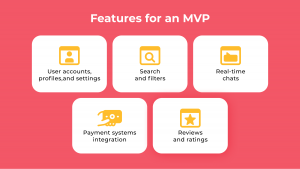
The Concept Analysis and Validation
First off, before the concept implementation, you should analyze whether it is in demand. Ask yourself, what is the actual value of your idea, and what customer problems the site would solve. A couple of examples for inspiration: the famous BlaBlaCar site serves for providing cheap and quick travel between the cities, and Airbnb offers accommodations for tourists at affordable prices.
Defining the problem to deal with, analyze the domain leaders as well as your potential competitors. Broadly speaking, since all the prospective domains may be filled, you’ll have to look for another focus in the preferred niche with less competition. For instance, Amazon launched their business the same way, selling only books at first.
Conduct thorough audience research. It’s important for you to understand more people’s expectations and the pain points connected to your chosen niche and find a way to solve it with your product.
Prove Your Site Concept
Having a unique site idea is not enough for a successful implementation. You should ensure that you’re on the right track with your business concept. So, interview your future consumers (not friends or family members) in order to obtain an unbiased assessment, make a brainstorm session with your business associate, and answer the questions below using the collected data.
- How often would you apply to your solution?
- How well do your potential customers realize the product aims?
- How much are you dependent on outside resources?
- What is the total size of the domain market?
This is not a complete question list, and you can extend it according to the current business situation. But don’t forget to do it because such little research can save you from potential mistakes and time losses.
After the idea validation, you can address a software development vendor. They would help you turn your concept into a full-fledged website and provide you with the human resources required for the development.

Proceed With Discovery Stage
The interaction with the vendor starts from the discovery and planning stage. It means continuous analysis conducted, discussions about the requirements, needed feature set, etc., and approvals. The planning stage tasks may include the following ones:
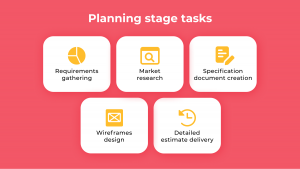
The software development team and the customers often have different visions of the required feature set and its implementation. That’s why the project specification (created during the discovery stage) is necessary for the development process because all the data concerning the functionality, its design or complexity, would be reflected there. The specification also helps every team player properly understand the customer’s expectations, requirements of the project and start working on it.
At the discovery stage, the customers can also choose whether to postpone the building process or keep collaborating with a web development company.
Marketplace Website Development
You can create a marketplace site using one of the existing site builders or develop the functionality from the very beginning. Working with a website constructor would be reasonable if you are on a tight budget and need a product urgently. The custom development, in its turn, will result in a website tailored to the needs of the particular business.
Prototype Building & Concept Testing
In order to obtain a top-notch site prototype (or a graphic model), you should continue collaborating with a software development company. You can share your prototype ideas, and the designers will implement them according to the latest software development trends.
Prototyping your site concept is the best way to test your idea’s viability and gain first investments. However, such a model cannot be fully used, and in order to animate it, you should implement the basic functionality during the MVP stage.
Building a Site MVP
A minimum viable product building means preparing a site having enough features to engage users and gather feedback. After earning a profit, you can use it to implement additional functionality.
An MVP version of your marketplace site may contain the following features:
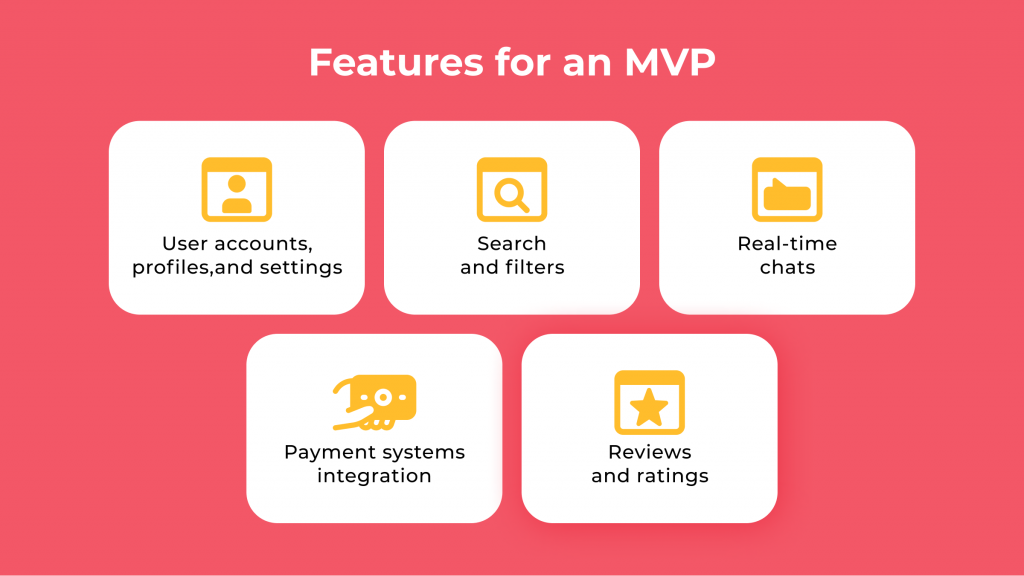
You can also add to your website the advanced functionality. It would be the following for the purchasers: wishlist, cost comparison, share to social media, push notifications, search engine, and gift vouchers. Such functions as items management or customers’ behavior data might be interesting for the merchants.
After the additional functionality is implemented, you can test the system in order to reveal and fix the bugs and then launch your marketplace website. Finally, don’t forget to prepare an appropriate marketing strategy to promote your new platform.
Significant Components for Building a Site
Creating an eBay or Amazon-like marketplace site, pay attention to the details below.
- A domain title. It is your site’s short address required for users to find and connect to it on the Internet (like ebay.com or amazon.com). Remember that it should be short and SEO-friendly (containing the keywords and having no hyphens or digits). On top of that, make it relevant and associated with your logo.
- A content management system (CMS). This platform (e.g., Joomla or WordPress) is intended to save development time and cut costs to build a site. The marketplace owners can also publish and edit the content there or even change the look of their Internet shop.
- A Secure Socket Layer (SSL) certificate. Such a thing is a sort of digital signing for your website, providing it with security and privacy. Furthermore, Google appreciates SSL-enabled websites and ranks them higher.
- Payment handling. The transactions should be processed from purchasers to merchants directly (without involving your site), parallelly (the payments are distributed between the sellers and your website), and aggregately (your platform puts together the purchasers’ funds and allocates them among the merchants).
- Web hosting account. This is a place for all data storage. As soon as people tap your site name in the search box, it turns into the IP address of your hosting vendor’s PC. The most popular hosting vendors are Hostinger, Bluehost, and Hostgator.
The Team Composition for Building a Marketplace Site
The development team helping you create a site should contain the following specialists:
- A project manager (PM) knowing all the ins and outs of the commercial site’s creation to properly organize and track the workflow
- Web developers specializing in making web apps: writing code to build the client-side and the backend
- UI/UX designers responsible for providing operational convenience for every user, appealing interface, and intuitive navigation
- QA engineers monitoring the development workflow, checking the product’s correspondence to the world regulations, and searching for bugs
Marketplace Site Development Costs
The prices can be calculated depending on the required functionality and the price list of your service provider. So, approximately you may need from $30,000 to $200,000 for the marketplace website development.
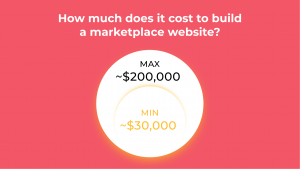
The building price is determined by the amount of development and non-development time. The number of hours is based on the complexity of the feature set, which includes both frontend and backend. You may need roughly 1500 hours; however, this value can be varied due to the project’s complexity.
Things to Consider for Making a Site Successful
Don’t hurry up to launch your marketplace website. Think about its effectiveness in customers’ attraction. First off, you should start working with merchants, convincing them of the permanent profitability of your resource.
Searching for sellers, make the following steps:
- Choose active ones on the opponent marketplaces and get in touch with them
- Find providers for your unique domain via Google Search or various business directories
- Check the appropriate Facebook groups or Internet forums
Inviting providers to be the first users of your site, obtain the loyalty of the potential purchasers. We’ve prepared advice on how to do it usefully.
- Before launch, prepare a landing page to receive emails
- Attend topical groups or forums to mention your marketplace site or start your own blog if you haven’t found an appropriate community
- Get in touch with influencers from your core audience, invite them to be your first ambassadors
Having a list of the engaged purchasers, you can launch your website. But keep in mind that all the preparations are also necessary as they help increase demand and boost your platform. Extending your marketplace after release, configure KPIs to monitor the efficiency and find site components that need upgrading.
- Check the usage metrics (e.g., bounce and conversion rates)
- Verify the business metrics (such as revenue, ROI, or customer acquisition)
- Control the transaction metrics (like repeat purchase rate)
Checking the metrics above will help you understand the users’ behavior and find the product’s weak points to improve.
Top-5 Marketplace Websites
Let’s look at the most popular and efficient marketplaces regarding customer care, usage convenience, and other factors.
Amazon
With a global market share of 9.4%, Amazon is the most popular marketplace platform on the planet. Its major selling benefit is giving access to a database of 100 million Prime members, who spend roughly $1,400 each year on Amazon, compared to $600 for ordinary customers. It makes Amazon a desirable destination for businesses.
Amazon’s selling plan is perfect for merchants that need to get started straight away. But, if you offer particular items in specialty categories (e.g., fine art or collectibles), you must subscribe to a professional plan and seek authorization.
Experienced merchants must pay $39.99 each month, additional costs per item sold, different closing charges, and referral commissions, depending on the goods’ category. Individual selling plans start at $0.99 per sale, with commissions that also differ by type.
eBay
With a vast market share, eBay is the world’s second-largest marketplace. It allows services to 168 million qualified buyers globally, who earn $95 billion annually. The platform charges two types of fees: an insertion fee and a final value fee (when the item is sold). You don’t have to pay for various commissions or primary setups.
Walmart
It has a user base of about 440 million active customers. You must be invited first to begin selling on Walmart. Then, you may also add your products to Walmart’s product selection. Just complete the forms to make the operation possible.
You may also engage in affiliate programs, which allow you to earn money on purchases made by referring consumers to the platform. Setups, monthly, and yearly usage are all free of charge on the site.
Etsy
Etsy is an online community where creative individuals can sell handmade products, communicate and share their experiences, supporting one another. The marketplace draws in both amateurs and experts by allowing them to share their works with the world. Buyers do not need to call the support manager if they have questions but directly contact the seller.
Etsy’s most important income models are as follows:
- For posting products online, sellers pay as low as $0.20. This offer is valid for 4 months.
- Aside from that, the marketplace takes a 3.5 percent commission from each sale. The sellers can choose their own sale price, but the platform subtracts a 3.5 percent fee before delivering funds to the vendor.
- Sellers might pay a fee to have access to more features (e.g., advertising options).
Taobao
Taobao is a Chinese marketplace with no transaction costs for both consumers and sellers. Rather, it makes money by charging vendors for SEO-style advertising (like Google). That’s why Taobao’s commercial aim is to attract as many merchants as they can to the website in order to compete for consumers’ attention and for the platform to collect marketing fees.
Taobao earns profit on Tmall (B2C platform of Taobao Mall) by charging businesses fees to validate and set up a store. The merchants have to pass verification before paying for each subsequent transaction to Taobao. The commission is around 5%.
Alipay (a Chinese online payment company) collects fees from merchants as well. For each concluded sale, merchants must pay a 0.55 percent charge. The system will not charge a fee if the withdrawals are less than 3,000 USD. Sellers must pay a 0.1 percent charge on any amount beyond this.
Wrapping Up
This article covers only the basics of marketplace site development. To obtain a more comprehensive picture, you should apply to a skillful software development team. The specialists will help you make the site user-friendly and connect all the innovative tools to develop an excellent customer experience and increase your business value.
My name is Katherine Orekhova and I am a technical writer at Cleveroad – mobile app development company. I’m keen on technology and innovations. My passion is to tell people about the latest tech trends in the world of IT.















